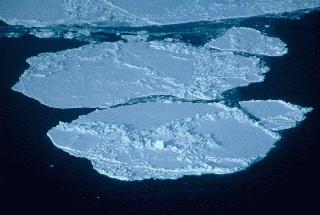
Scott Schliebe/USFWS
Polar Bears on Thin Ice
Polar bears live in one of our planet’s most extreme environments, the Arctic . They thrive in the freezing cold. But because of global warming, polar bears might be in trouble. Scientists are studying whether polar bears should be added to the list of threatened species under the US Endangered Species Act.
Roaming across Arctic sea ice, polar bears peer through cracks in the ice to look for ringed seals, their favorite food, in the water below. The floating sea ice is the perfect place for the bears to find food. Unfortunately, the amount of sea ice floating in the Arctic Ocean is shrinking each year. The ice is melting as the Earth is warming. Within the next 40 years or so, there may be no more sea ice in the Arctic Ocean during the summer. Pieces of sea ice are getting smaller and farther apart. The bears must swim further to get from one piece of ice to another. The bears are swimming 60 miles or more through the Arctic Ocean in search of ice.
Polar bears are good swimmers. However, because the bears now have to swim farther to find the next piece of sea ice, some become exhausted during the long journey and drown.
Polar bears are moving to land on the north coast of Alaska because the sea ice is melting and it no longer connects to shore. This separates the bears from their preferred hunting grounds, the sea ice. With less sea ice, polar bears cannot hunt for food as often, and so they wind up with less to eat. Scientists have found that polar bears weigh less than they used to and that polar bear cubs off the North coast of Alaska are less likely to survive. In Canada’s Hudson Bay the number of bears has dropped.
During 2007, scientists in the United States studied whether polar bears should be added to their list of threatened species. On May 14, 2008 they added polar bears to the list. This is the first time a species has been added under the Endangered Species Act because of global warming.
Sea ice is melting so quickly that only a much smaller number of polar bears will be able to survive according to the United States Geological Survey (USGS). This means that there will be only about one third the number of polar bears by the middle of this century.














